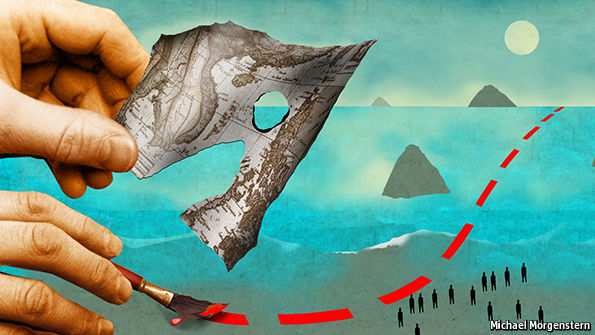
WITH all respect to the endearing Fu Yuanhui, the Olympic swimmer whose goofy post-race interviews have made her a global star, the Chinese are creatures of the land, not the water. On the beaches of Sanya on the southern island of Hainan, China’s new Hawaii, crowds of holidaymakers in tropical shirts dabble awkwardly at the water’s edge; few actually plunge into the sea. In the Sanya market a fishmonger explains a national aversion to deep water more bluntly: the Chinese, she says, simply don’t have sea legs. Refusing to go afloat herself, she buys her fish from the boat people living in the harbour, an ethnic subgroup whose generations have come into the world afloat and gone out the same way. Tanka, as these people are called in southern China, have historically faced discrimination. Even the name, “egg people”, has the force of an insult in Chinese (they call themselves “on-the-water people”).
So it is striking how large water now looms in China’s diplomatic calculations and in the region’s geopolitics, nowhere more so than in the South China Sea that Sanya looks out on. It is there that the gunboat diplomacy which China has employed in recent years to back expansive maritime claims has stirred nervousness among South-East Asian neighbours—and created fears of a collision with America.
Sanya is part of the story. An expanding deepwater naval base there is intended to project China’s power far into the South China Sea and to support a new archipelago of artificial islands that China has built on reefs and atolls a long way from Chinese shores. Three of these bases in the Spratly islands have military-length runways, and recent satellite pictures show the construction of concrete bunkers, presumably for fighter jets. Back in Sanya, a base for nuclear submarines cuts into the mountainside. Even Hainan’s lowly fishermen play a part. Formed into waterborne “people’s militias”, their vessels have grabbed fishing grounds far from home by chasing off their counterparts from neighbouring countries, such as the Philippines and Vietnam.
China reacted with fury. The nine-dash line has long been a matter of national pride. A recent letter to The Economist from the foreign ministry asserts that there are “ample historical documents and literature” to show that China was “the first country to discover, name, develop and exercise continuous and effective jurisdiction over the South China Sea islands”. Bunkum. As Bill Hayton points out in his book, “The South China Sea”, the first Chinese official ever to set foot on one of the Spratlys was a Nationalist naval officer in 1946, the year after Japan’s defeat and loss of control of the sea; he did so from an American ship crewed by Chinese sailors trained in Miami. As for the story of the nine-dash line, it begins only a decade earlier with a Chinese government naming commission. China was not the first to name the islands; the commission borrowed and translated wholesale from British charts and pilots.
Yet no Chinese official could ever admit this. The nine-dash line has for decades graced maps of China in every schoolroom in the land—part of what one academic has described as a cartography of humiliation: a narrative about what China lost in the past to imperialist depredations and what it rightly owns today.
So what happens next? To some, laying bare China’s claims will only raise the stakes. When a Singaporean author and former diplomat, Kishore Mahbubani, predicted earlier this month that tensions would not lead to military conflict between China and America, the auditorium broke into applause—as much for the boldness of his assertion as in the hope that he may be right. Some predict that China will take advantage of what is left of Barack Obama’s presidency to start building on the disputed Scarborough Shoal, from which Chinese ships dislodged the Philippine navy in 2012. America has suggested that such a move would constitute a red line. But, fairly or not, Mr Obama does not have the reputation of an energetic enforcer of red lines.
China will not necessarily act provocatively. Challenging America, backed as it is by much of South-East Asia, carries risks. Besides, despite its legal setback, China’s military position in the South China Sea is stronger than ever—even without a base on Scarborough Shoal. The trip to Hong Kong last week of a former president of the Philippines, Fidel Ramos, to meet senior Chinese officials and try to improve roiled relations, had the air of a vassal’s visit. The imperial power could now be magnanimous, allowing Philippine fishermen to fish where they always have.
There are other seas full of fish
China’s latest actions may be to please a nationalistic audience back home. They may be to warn a new, right-wing cabinet in Japan against visiting Tokyo’s militaristic Yasukuni shrine around the anniversary of the end of the second world war. (No member has.) Or they may simply be to show who calls the tune in East Asia these days—now it’s Japan’s turn to dance.
http://www.economist.com/news/asia/21705373-if-long-standing-tensions-ease-south-china-sea-china-will-ensure-they-rise-elsewhere-full


No comments:
Post a Comment
Note: Only a member of this blog may post a comment.